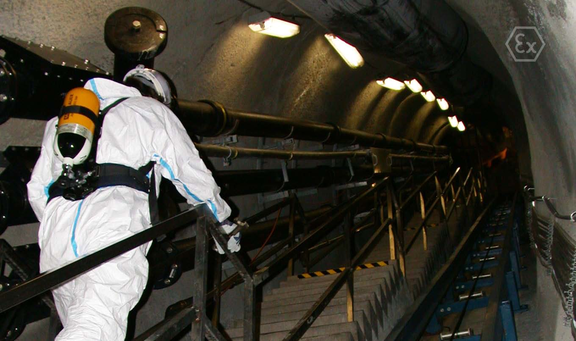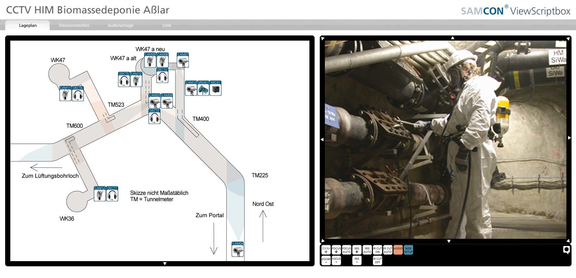Camera and Communication Technology at Landfill Mine "Deponie Asslar"
The Toughest Camera and Communication Technology Requirements in Explosion Risk Zones

System: Eleonore Tunnel of the Asslar Biomass Landfill Site. 1000 metres of underground tunnel. 1000 metres of tunnel away from the plant measuring station. Explosion Risk Sub-Zones. Pipe-cleaning work with a maximum water pressure of up to 900bar. Camera and Communication System Requirement: Consistent monitoring of the entire gallery with explosion protected camera systems. Full-duplex voice communication between the work groups under complete breathing protection and the tunnel surveillance team in the plant monitoring station. Complete integration of the camera and communication system in the process control system.
From 1977 to 1992, conditioned sewage sludge (biomass) was stored at the Asslar landfill site near Wetzlar by the companies who at that time were known as Hoechst AG and Casella AG. Owing to the drainage situation, in 1994 the operator, HIM GmbH, planned and built an underground tunnel system to be able to better discharge the landfill site percolating water. The Eleonore Tunnel runs through natural rock underneath the stored biomass and thereby enables direct access to the three percolating water drainage points (maintenance chambers). With all the crossways, the entire tunnel length measures around 1,000 metres.
The escaping landfill site percolating water brings with it two properties, which make regular work in the tunnel essential. On the one hand, liming occurs in the drain pipes, making constant cleaning a necessity, and on the other hand, methane is located in the pipelines, which may leak when opened and could result in an explosive atmosphere.
Camera and Communication System Requirements
Because the working conditions are tough for both people and device technology, maximum requirements are placed on the camera and communication system: Four ATEX-certified zoom cameras (ExCam® miniZoom) as well as five explosion protected dome camera systems (ExCam® 360°) share the task of making every workspace in the Eleonore Tunnel visible and capable of being monitored for a kilometre from their location in the plant measuring station. In the outdoor area, the system is rounded off by three weatherproof dome cameras. In addition to a visual connection to the work in the tunnels, a voice connection to the workers in the tunnel is required, too. The workers in the Eleonore Tunnel have to be able to communicate among themselves under complete breathing protection, in addition to ensuring full-duplex communication, i.e. without having to press a "push to talk" button, with the plant measuring station.
Four ATEX-certified DECT base stations (DECT ExNF Interface) installed in the Eleonore Tunnel establish a radio connection with Ex-Headsets (see image 2) if necessary. The workers in the explosion risk zone can talk to one another by way of these headsets. The measuring station is connected to the headsets using a "Voice over IP" (VoIP) connection via the network. The operators in the measuring station can therefore ensure full-duplex communication with the workers in the explosion risk zone, and warnings and information can be exchanged. connected to the headsets using a "Voice over IP" (VoIP) connection via the network. The operators in the measuring station can therefore ensure full-duplex communication with the workers in the explosion risk zone, and warnings and information can be exchanged.
Speaking and Seeing through the Ether — The Ethernet as a Communication Medium of the Future.
In the Eleonore Tunnel, there is only one answer to the question as to how the video and audio signals can be optimally transferred, i.e. without loss, to the explosion risk zone over the long installation paths: as digital network streams in the TCP/IP protocol. The camera network in the tunnel was designed in the ignition protection type [op is] as a FOC (fibre optic cable) network. This ignition protection type ensures "intrinsic safety" based on the EN 60079-28 standard. This means that, with respect to its maximum output, the light routed into the explosion risk zone is not capable of generating an ignitable spark. Participants, such as the ExConnection Rail -QA (see image 2) can be connected to this intrinsically safe network, which can be expanded in any way.
From the safe zone, the network is not different from a conventional one located in a non-explosion risk zone. If necessary, it can be connected via a firewall to other networks, such as the process control system (PCS) network or to the Internet. Once the video and audio data is available as digital network streams, there are no limits with regard to usability. Functions such as camera control, layout plan navigation, the opening and closing of voice channels, recording and remote access are reduced to software requirements and no longer require any additional hardware!
Operating and Observing – Complete Integration in Control and Process Control Systems.
Why establish a "stand alone" camera visualisation system in addition to the visualisation of the process control system, when both systems can be intelligently connected? Does the camera visualisation system not have to provide the system operator or operator with important information, too? PCS, camera interfaces and communication interfaces are provided in a control room to a team of operators for targeted intervention. Based on these considerations, and owing to the spatial tightness in the plant measuring station, the camera and communication system of the Asslar biomass landfill site was integrated in the Freelance® 2000 control system of ABB. The SAMCON®trol web server application prepares the video and audio signals for this such that they can be called up by URL. With this technology, installation of video clients software is no longer required. The browser, be it installed on the operating system or integrated in the PCS, takes on all of its tasks. By way of dynamic html scripts (ViewScriptbox – see image 3), the user can individually compile the desired visualisation with layout plan navigation, grouped video thumbs; lists and recording archives. The pages created in this way can then be called up from the PCS manually or automatically (event triggered).
Conclusion.
At the Asslar biomass landfill site, the camera and communication system has lost its special status in the plant measuring station. Cameras, headsets, loudspeakers and microphones are becoming process control sensors and actuators and are being seamlessly incorporated into the process control system. Recording, control and display of live images, as well as the opening and closing of voice channels, are becoming additional functions of the visualisation stations!
Find out more about the equipment that was used on site:
